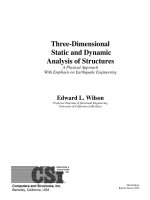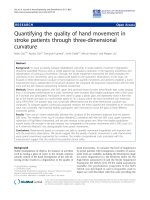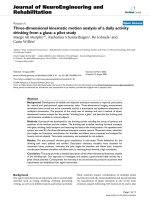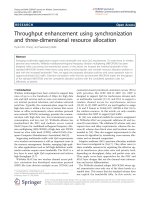Three Dimensional Integration and Modeling A Revolution in RF and Wireless Packaging by Jong Hoon Lee Emmanuil Manos M Tentzeris and Constantine A Balanis_8 ppt
Bạn đang xem bản rút gọn của tài liệu. Xem và tải ngay bản đầy đủ của tài liệu tại đây (8.42 MB, 12 trang )
75
CHAPTER 6
Three-Dimensional Antenna
Architectures
6.1 SOFT-SURFACE STRUCTURES FOR
IMPROVED-EFFICIENCY PATCH ANTENNAS
The radiation performance of patch antennas on large-size substrate can be significantly degraded
by the diffraction of surface waves at the edge of the substrate. Most modern techniques for the
surface-wave suppression are related to periodic structures, such as photonic band-gap (PBG) or
electromagnetic band-gap (EBG) geometries [87–89]. However, those techniques require a con-
siderable area to form a complete band-gap structure. In addition, it is usually difficult for most
printed-circuit technologies to realize such a perforated structure. In this chapter, we present the
novel concept of the “soft surface” to improve the radiation pattern of patch antennas [90]. A single
square ring of shorted quarter-wavelength metal strips is employed to form a soft surface and to sur-
round the patch antenna for the suppression of outward propagating surface waves, thus alleviating
the diffraction at the edge of the substrate. Since only a single ring of metal strips is involved, the
formed“soft surface”structureiscompactandeasily integrable with three-dimensional(3D)modules.
6.1.1 Investigation of an Ideal Compact Soft Surface Structure
For the sake of simplicity, we consider a probe-fed square patch antenna operating at 15 GHz on
a square grounded substrate with thickness H (∼0.025
0,
0
is the free-space wavelength) and a
dielectric constant ε
r
(∼5.4). The patch antenna is surrounded by the ideal compact soft surface that
consists of a square ring of metal strip, that are short-circuited to the ground plane by a metal wall
along the outer edge of the ring, as shown in Fig. 6.1.
The inner length of every side of the soft surface ring (denoted by L
s
) was found to be
approximately one wavelength plus L
p
. The substrate’s size is assumed to be L ×L (2
0
×2
0
),
much larger than the size (L
p
×L
p
< 0.5
g
×0.5
g
) of the square patch. The width of the metal
strip (W
s
) is approximately equal to one quarter of the guided wavelength. The mechanism for the
radiation pattern improvement achieved by the introduction of a compact soft surface structure can
be understood by considering two factors. First the quarter-wave shorted metal strip serves as an
open circuit for the TM
10
mode (the fundamental operating mode for a patch antenna). Therefore,
it is difficult for the surface current on the inner edge of the soft surface ring to flow outward
76 THREE-DIMENSIONAL INTEGRATION
FIGURE 6.1: Patch antenna surrounded by an ideal compact soft surface structure consisting of a ring
of metal strip and a ring of shorting wall (I
s
, surface current on the top surface of the soft surface ring,
Z
s
, impedance looking into the shorted metal strip).
(also see Fig. 6.2). As a result, the surface waves can be considerably suppressed outside the soft
surface ring, hence reducing the undesirable diffraction at the edge of the grounded substrate.
Thisexplanationcan be confirmed by checkingthefielddistribution in the substrate. Figure6.2
shows the electric field distributions on the top surface of the substrate for the patch antennas with
THREE-DIMENSIONAL ANTENNA ARCHITECTURES 77
FIGURE 6.2: Simulated electric field distributions on the top surface of the substrate for the patch
antennas with (a) and without (b) the soft surface (ε
r
= 5.4).
78 THREE-DIMENSIONAL INTEGRATION
and without the soft surface. We can see that the electric field is indeed contained inside the soft
surface ring. It is estimatedthat the field magnitude outside the ring is approximately 5dB lower than
that without the soft surface. The second factor contributing to the radiation pattern improvement
is the fringing field along the inner edge of the soft surface ring. This fringing field along with the
fringing field at the radiating edges of the patch antenna forms an antenna array in the E-plane. The
formed array acts as a broadside array with minimum radiation in the x-y plane when the distance
between the inner edge of the soft surface ring and its nearby radiating edge of the patch is roughly
half a wavelength in free space.
6.1.2 Implementation of the Soft-Surface Structure in LTCC
To demonstrate the feasibilit y of the multilayer LTCC technology on the implementation of the soft
surface, we first simulated a benchmarking prototype that was constructed replacing the shorting wall
with a ring of vias. The utilized low temperature cofired ceramic (LTCC) material had a dielectric
constant of 5.4. The whole module consists of a total of 11 LTCC layers (layer thickness =100 m)
and 12 metal layers (layer thickness =10 m). The diameter of each via specified by the fabrication
process was 100 m, and the distance between the centers of two adjacent vias was 500 m. To
support the vias, a metal pad is required on each metal layer; to simplify the simulation, all pads
on each metal layer are connected by a metal strip with a width of 600 m. Simulation shows that
the width of the pad metal strips has little effect on the performance of the sof t surface structure
as long as it is less than the width of the metal strips for the soft surface ring (W
s
). The size of the
LTCC board was 30 mm×30 mm. The operating frequency was set within the K
u
-band (the design
frequency f
0
=16.5 GHz).
The optimized values for L
s
and W
s
were, respectively, 22.2 mm and 1.4 mm, which led to a
total via number of 200 (51 vias on each side of the square ring). Including the width (300 m) of the
pad metal strip, the total metal strip width for the soft surface ring was found to be 1.7 mm. Since
the substrate was electrically thick at f
0
=16.5 GHz (>0.1
g
), a stacked configuration was adopted
for the patch antenna to improve its input impedance performance. By adjusting the distance
between the stacked square patches, a broadband characteristic for the return loss can be achieved
[91]. For the present case, the upper and lower patches (with the same size 3.4 mm ×3.4 mm) were
respectively printed on the first LTCC layer and the seventh layer from the top, leaving a distance
between the two patches of 6 LTCC layers. The lower patch was connected by a via hole to a 50-
microstrip feed line that was on the bottom surface of the LTCC substrate. The ground plane was
embedded between the second and third LTCC layers from the bottom. The inner conductor of
an SMA (semi-miniaturized type-A) connector was connected to the microstr ip feed line while its
outer conductor was soldered on the bottom of the LTCC board to a pair of pads that were shorted
to the ground through via metallization. It has to be noted that the microstrip feed line was printed
on the bottom of the LTCC substrate to avoid its interference with the soft surface r ing and to
THREE-DIMENSIONAL ANTENNA ARCHITECTURES 79
12 13 14 15 16 17 18 19 20
-25
-20
-15
-10
-5
0
measured
simulated
Return loss (dB)
Frequency (GHz)
12 13 14 15 16 17 18 19 20
-25
-20
-15
-10
-5
0
measured
simulated
Return loss (dB)
Frequency (GHz)
FIGURE 6.3: Comparison of return loss between simulated and measured results for the stacked-patch
antennas with (a) and without (b) the soft surface implemented on LTCC technology.
alleviate the contribution of its spurious radiation to the radiation pattern at broadside. An identical
stacked-patch antenna on the LTCC substrate without the soft surface ring was also built for
comparison.
The simulated and measured results for the return loss shown in Fig. 6.3 show good agree-
ment. As the impedance performance of the stacked-patch antenna is dominated by the coupling
between the lower and upper patches, the return loss for the stacked-patch antenna seems more
sensitive to the soft surface structure than that for the previous thinner single patch antenna. The
measured return loss is c lose to −10 dB over the frequency range 15.8–17.4 GHz (about 9% in
bandwidth). The slight discrepancy between the measured and simulated results is mainly due to the
fabrication issues (such as the variation of dielectric constant or/and the deviation of via positions)
and the effect of the transition between the microstrip line and the SMA (SubMiniature version A)
connector.
It is also noted that there is a frequency shift of about 0.3 GHz (about 1.5% up). This is
probably caused by the LTCC material that may have a real dielectric constant slightly lower than
the over estimated design value. It is noted that it is normal for practical dielectric substrates to have
a dielectric constant within a ±2% deviation.
The radiation patterns measured in the E- and H-planes show a good agreement with the
simulation with the simulated results in Fig. 6.4 for the frequenc y of 17 GHz where the maximum
gain of the patch antenna with the soft surface was observed. It is confirmed that the radiation at
broadside is enhanced and the backside level is reduced. Also the beam width in the E-plane is
significantly reduced by the soft surface, realizing a more directive radiation performance. It is noted
80 THREE-DIMENSIONAL INTEGRATION
E-plane ( =0
o
)
180
o
150
o
120
o
-150
o
-120
o
|E| (dB) -40 -30 -20 -10 0
z
x
-90
o
-60
o
-30
o
30
o
=0
o
60
o
90
o
Measured co-pol.
Simulated co-pol
Measured cross-pol
E-plane ( =0
o
)
180
o
150
o
120
o
-150
o
-120
o
|E| (dB) -40 -30 -20 -10 0
z
x
-90
o
-60
o
-30
o
30
o
=0
o
60
o
90
o
Measured co-pol.
Simulated co-pol.
Measured cross-pol.
(a) E-plane ( =0 )
H-plane ( =90
o
)
180
o
150
o
120
o
-150
o
-120
o
|E| (dB) -40 -30 -20 -10 0
z
y
-90
o
-60
o
-30
o
30
o
=0
o
60
o
90
o
Measured co-pol.
Simulated co-pol
Measured cross-pol.
Simulated cross-pol.
H-plane ( =90
o
)
180
o
150
o
120
o
-150
o
-120
o
|E| (dB) -40 -30 -20 -10 0
z
y
-90
o
-60
o
-30
o
30
o
=0
o
60
o
90
o
Measured co-pol
Simulated co-pol
Measured cross-pol.
Simulated cross-pol.
(b) H-plane ( =90 )
FIGURE 6.4: Comparison between simulated and measured radiation patterns for the stacked-patch
antennaswith(left) and without (right) the softsurface implemented on LTCC technology ( f
0
=17 GHz).
(a) E-plane ( =0
◦
). (b) H-plane ( =90
◦
).
that the measured cross-polarized component has a higher level and more ripples than the simulation
result. This is because the simulated radiation patterns were plotted in two ideal principal planes,
i.e., =0
◦
and =90
◦
planes. The simulations demonstrated that the maximum cross-polarization
may happen in the plane =45
◦
or =135
◦
. During measurement, a slight deviation from the
ideal planes can cause a considerable variation for the cross-polarized component since the spatial
variation of the cross-polarization is quick and irregular.
THREE-DIMENSIONAL ANTENNA ARCHITECTURES 81
Also, a slight polarization mismatch or/and some objects near the antenna (such as the con-
nector or/and the connection cable) may considerably contribute to the high cross-polarization. In
addition, the maximum gain measured for the patch with the soft sur face is near 9 dBi, about 3 dB
higher than the maximum gain and 7 dB higher than the gain at broadside for the antenna without
the soft surface.
6.2 HIGH-GAIN PATCH ANTENNA USING A COMBINATION
OF A SOFT-SURFACE STRUCTURE AND A STACKED CAVITY
The advanced technique of the artificial soft surface consisting of a single square ring of metal strip
shorted to the ground demonstrated the advantages of compact size and excellent improvement
in the radiation pattern of patch antennas in section 6.1. In this section, we further improve this
technique by adding a cavity-based feeding structure on the bottom LTCC layers [substrate 4 and 5
in Fig. 6.5(c)] of an integrated module to increase the gain even more and to reduce future backside
radiation. The maximum gain for the patch antenna with the soft surface and the stacked cavity is
approximately 7.6 dBi that is 2.4 dB higher than 5.2 dBi for the “soft-enhanced” antenna without
the backing cavity.
6.2.1 Antenna Structure Using a Soft-Surface and Stacked Cavity
The 3D overview, top view and cross-sectional view of the topology chosen for the micostrip antenna
using a soft-surface and a vertically stacked cavity are shown in Fig. 6.5(a), (b) and (c), respectively.
Theantenna is implemented into fiveLTCCsubstratelayers(layerthickness =117 m) andsixmetal
layers (layer thickness =9 m). The utilized LTCC is a novel composite mater ial of high dielectric
constant (ε
r
∼7.3) in the middle layer (substrate 3 in Fig. 6.5(c)) and slightly lower dielectric constant
(
r
∼7.0) in the rest of the layers [substrate 1–2 and 4–5 in Fig. 6.5(c)]. A 50 stripline is utilized
to excite the microstrip patch antenna (metal 1) through the coupling aperture etched on the top
metal layer (metal 4) of the cavity as shown in Fig. 6.5(c). In order to realize the magnetic coupling
by maximizing magnetic currents, the slot line is terminated with a
g
/4 open stub beyond the slot.
The probe feeding mechanism could not be used as a feeding structure because the size of the
patch at the operating frequency of 61.5 GHz is too small to be connected to a probe via according to
the LTCC design rules. The patch antenna is surrounded by a soft surface structure consisting of a
square ring of metal strips that are short-circuited to the ground plane [metal 4 in Fig. 6.5(c)] for the
suppression of outward propagating surface waves. Then, the cavity [Fig. 6.5(c)], that is realized uti-
lizing the vertically extendedviafencesof the “soft sur face” as its sidewalls,isstacked right underneath
theantennasubstratelayers[substrates 4 and 5 in Fig.6.5(c)]tofurther improvethegainandtoreduce
backside radiation. The operating frequency is chosen to be 61.5 GHz; the optimized size (P
L
×P
W
)
of patch is 0.54 ×0.88 mm
2
with the rectangular coupling slot (S
L
×S
W
=0.36 ×0.74 mm
2
). The
size (L ×L) of the square ring and the cavity is optimized to be 2.6 ×2.6 mm
2
to achieve the
82 THREE-DIMENSIONAL INTEGRATION
FIGURE 6.5: (a) 3D overview, (b) cross-sectional view, and (c) cross-sectional view of a patch antenna
with the soft surface and stacked cavity.
THREE-DIMENSIONAL ANTENNA ARCHITECTURES 83
maximum gain. The width of metal strip (W) is found to be 0.52 mm to serve as an open circuit for
the TM
10
mode of the antenna. The ground planes are implemented on metals 4 and 6.
We achieved the significant miniaturization on the ground planes because their size exclud-
ing the feeding lines is the same as that of the soft surface (≈3.12×3.12mm
2
). In addition, the
underlying cavity is used both as a dual-mode filter to separate the TM
10
mode whose phase and
amplitude contain the information transmitted through short-range indoor wireless personal area
network (WPAN) and as a reflector to improve the gain.
6.2.2 Simulation and Measurement Results
The simulated (HFSS) and the measured results for the return loss are shown in Fig. 6.6. The
measured return loss is close to −10 dB over the frequency range 58.2–62.3 GHz (about 6.6%
in bandwidth). The slight discrepancy between the measured and simulated results is mainl y due
to the fabrication issues, such as the variation of dielectric constant or/and the deviation of via
positions. From our investigation on the impedance performance, it is noted that the soft-surface
structure vertic ally stacked by the cavity does not affect significantly on the bandwidth of the
patch.
We compared the gains among the patch antennas with the soft surface and the stacked cavity,
with the soft surface only, and without the soft surface. The simulated gains at broadside (i.e., the
z-direction) are shown in Fig. 6.7. The simulated gain was obtained from the numerically calculated
directivity in the z-direction and the simulated radiation efficiency, which is defined as the radiated
56 58 60 62 64
-40
-30
-20
-10
0
dB
Frequency (GHz)
simulated
measured
FIGURE 6.6: Comparison of return loss between simulated and measured results for a patch antenna
with the soft surface and the stacked cavity implemented on LTCC technology.
84 THREE-DIMENSIONAL INTEGRATION
56 58 60 62 64 66
0
1
2
3
4
5
6
7
8
Gain (dBi)
Frequency (GHz)
w/ SS+cavity
w/SS
w/o SS
FIGURE 6.7: Comparison of simulated and measured gains at broadside between the stac ked-patch
antennas with and without the soft surface (SS) implemented in LTCC technology.
power divided by the radiation power plus the ohmic loss from the substrate and metal str uctures
(tan ı =0.0024 and =5.8 ×10
7
S/m were assumed for the Copper metallization). In Fig. 6.7,
we can see that the simulated broadside gain of the patch antenna with the soft surface and the
stacked cavity is more than 7.6 dBi at the center frequency, about 2.0 dB improvement as compared
to one with the soft surface only and 4.3 dB improvement as compared to one without the soft
surface.
More gain enhancementispossible with thethicker substratesince the thickersubstrate excites
stronger surface waves while the soft sur face blocks and transforms the excited surface waves into
space waves.
The radiation patternssimulatedin E andH planes ofpatchantennas with thesoft surfaceonly
and with the soft surface/stacked cavity are shown and compared in Fig. 6.8(a) and (b), respectively.
The radiation patterns compared here are for a frequency of 61.4 GHz where the maximum gain of
the patch antenna with the soft surface was observed. It is confirmed that the radiation at broadside
is enhanced by 2.4 dB and the backside level is significantly reduced by 5.1 dB by stacking the cavity
to the patch antenna with the soft surface. Also the beam width in the E-plane is reduced from 74
◦
to 68
◦
with the addition of the staked cavity.
THREE-DIMENSIONAL ANTENNA ARCHITECTURES 85
(a)
(b)
0
30
60
90
120
150
180
210
240
270
300
330
0
30
60
90
120
150
180
210
240
270
300
330
H-plane
E-plane
FIGURE 6.8: Radiation characteristics at 61.5GHz of patch antennas (a) with the soft surface and (b)
with the soft surface and the stac ked cavity.
6.3 DUAL-POLARIZED CROSS-SHAPED
MICROSTRIP ANTENNA
The next presented antenna for an easy integration with 3D modules is a cross-shaped antenna,
that was designed for the transmission and reception of signals that cover two bands between
59–64 GHz. The first band (channel 1) covers 59–61.25 GHz, while the second band (channel 2)
86 THREE-DIMENSIONAL INTEGRATION
covers 61.75–64GHz. Its structure is dual-polarized for the purpose of doubling the data output
rate transmitted and received by the antenna. The cross-shaped geometry was utilized to decrease
the cross-polarization that contributes to unwanted side lobes in the radiation pattern [92].
6.3.1 Cross-Shaped Antenna Structure
The antenna, shown in Fig. 6.9, was excited by proximity-coupling and had a total thic kness of 12
metal layers and 11 substrate layers (each layer was 100 m thick). Proximit y-coupling is a particular
method for feeding patch antennas where the feedline is placed on a layer between the antenna and
the ground plane. When the feedline is excited, the fringing fields at the end of the line strongly
couple to the patch by electromagnetic coupling. This configuration is a non-contact, non-coplanar
method of feeding a patchantenna, that allows different polarization reception of signals that exhibits
improved cross-channel isolation in comparison to a traditional coplanar microstrip feed.
There were two substrate layers separating the patch and the feedline, and two substrate layers
separating the feedline and the ground layer. The remaining seven-substrate layers were used for
embedding the radio frequency (RF) circuitry beneath the antenna; thatincludes the filter,integrated
passives and other components. The size of the structure was 8 ×7mm
2
. A right angle bend in the
feedline of channel 2 is present for the purpose of simplifying the scattering parameter measurements
on the network analyzer.
FIGURE 6.9: Cross-shaped antenna structure in LTCC.









